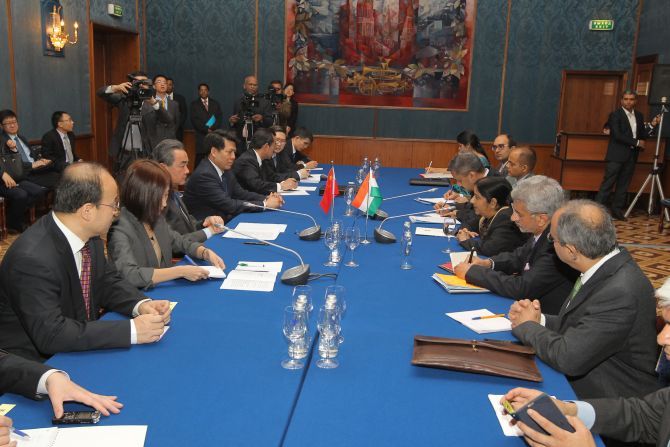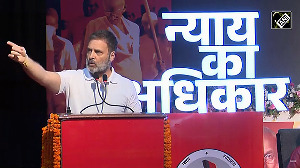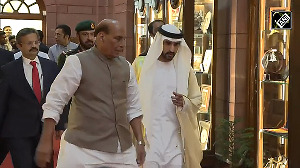The readouts by the Indian and Chinese sides on the meeting on Monday between External Affairs Minister Sushma Swaraj and her Chinese counterpart Wang Yi in Moscow bring out that divergences are crowding into the centrestage of their relationship, says Ambassador M K Bhadrakumar.

One almost forgot that it was only 25 years ago that the Treaty on Deepening Military Trust in Border Regions and the Treaty on Reduction of Military Forces in Border Regions among the “Shanghai Five” -- China, Russia, Kazkahstan, Kyrgyzstan and Tajikistan -- was signed in Beijing, which eventually paved the way for Russia and China to fully resolve the border issues and demarcate the border, a process that was completed with the initialing of the 2004 Complementary Agreement that led to transfer of territories (which was carried out by 2008).
Yet, today, seven years and six months later, Russia and China confidently affirm in one voice that their relations are at the highest level ever in history. Make no mistake, this was an intractable border dispute, traceable to the seventeenth century and characterised by military expansion (on both sides) and complicated by mutual territorial claims -- and not a mere leftover by a departing colonial power.
A highly influential Chinese pundit (who is also a renowned expert on Central Asia), Pan Guang, director of the Center of SCO Studies of the Shanghai Academy of Social Sciences, reflected recently on the lessons learnt from the Sino-Russian experience. He noted:
‘Many observers have been wondering why the five countries (Shanghai Five) solved the disputes over the 7,000-strong kilometres long border in such a short time. First, there must be mutual trust mechanisms. When the treaty was signed 20 years ago, it was just a single piece of paper. The five countries kept in touch with each other and invited each other to attend activities to enhance transparency and ease tensions in border areas. Such a treaty cannot be signed under confrontational circumstances, such as those between Azerbaijan and Armenia at present.
‘Second, the reduction of armaments helped. It is difficult to realise peace or non-militarisation in conflict zones. At this point, the parties involved should not be affected by external interventions and provocations. Meanwhile, once a general consensus for solving disputes is reached, concrete disputes between two countries should be solved bilaterally and should not involve third parties. As for thorny issues, we can resort to joint development and leave them to the end.’
Of course, none of these prerequisites seems to be available as regards the India-China border. A commentary in the Chinese communist party tabloid Global Times today points out that the Border Defence Cooperation Agreement of 2013, a landmark in the Sino-Indian border negotiations during the UPA rule, cannot be implemented due to “media hype” in India and the “tough stance on China taken by certain Indian politicians”.
The commentary reminds us that the 2013 pact does not amount to Chinese “acquiescence in the status quo” on the disputed border.
Meanwhile, it draws attention to confrontational circumstances welling up in the overall relationship -- specifically, the Indian proclivity to bandwagon with the US’s alliance system. Beijing anticipates that the visiting Defence Minister Manohar Parrikar on own accord might explain why India is doing a thing which is neither consistent with its independent foreign policies nor its self-interests, apart from carrying the risk of souring its ties with China.
Meanwhile, the readouts by the Indian and Chinese sides on the meeting on Monday between External Affairs Minister Sushma Swaraj and her Chinese counterpart Wang Yi (on the sidelines of the RIC meeting in Moscow) also bring out that divergences are crowding into the centrestage of the relationship. The Indian readout says:
‘EAM Smt Sushma Swaraj and Chinese Foreign Minister Wang Yi held a bilateral meeting on the sidelines of the RIC Ministerial meeting. Both Ministers reviewed the state of bilateral relations. They also assessed the implementation of decisions taken during Prime Minister Modi’s visit to China last May. They noted the significance of high level exchanges contemplated this year, including the on-going visit of Raksha Mantri Manohar Parrikar. China would be hosting the G20 Summit and India the BRICS Summit in 2016.
‘The ministers appreciated the expanding trade and investment ties between India and China. They underscored the importance of strengthening people to people ties. In this context, Foreign Minister Wang Yi apprised EAM of China’s decision to increase the number of Indian pilgrims for the Kailash Mansarovar Yatra via Nathu La.
‘EAM raised the issue of listing of Masood Azhar in the UN 1267 Committee and emphasised that as common victims of terrorism, China and India should cooperate in combating this challenge. It was agreed that the two sides would remain in touch on this matter.’
However, the Xinhua report, here (external link), refuses to share the contrived spin of convergence that the Indian version gave. It underscored, on the contrary, that Yi dwelt on what all is possible between the two countries if only India showed the political will.
In sum, EAM Swaraj faithfully executed the brief she was carrying, namely, give hell to the Chinese over the Masood Azhar issue at any and every opportunity -- “on the beaches, on the landing grounds, in the fields and in the streets”, as it were -- till they got embarrassed and caved in.
This also comes out in the EAM’s opening statement at the RIC meeting as well as in her media statement later in the presence of Yi (here and here, external links), which were loaded with Azhar-centric barbs. Suffice to say, the chill in the India-China relationship is palpable.
However, what lasting impression Swaraj would have made on Foreign Minister Yi, a veteran career diplomat, remains to be seen. It may be prudent to think up Plan B.
Perhaps, the year-old tough line toward China, choreographed by South Block mandarins, needs spunk. Go back to Ash Carter? Last we heard of him, he was in Iraq on a surprise visit to discuss the Mosul campaign against the Islamic State -- straight from visiting the American carrier strike group deployed in South China Sea (here, external link).
Image: External Affairs Minister Sushma Swaraj holds delegation-level talks with Chinese Foreign Minister Wang Yi in Moscow during her visit to Russia on April 18, 2016. Photograph: MEAphotogallery on Flickr.
Ambassador M K Bhadrakumar is a retired diplomat, who is widely acknowledged as one of the most authoritative experts on Afghanistan. Mr Bhadrakumar blogs at https://blogs.rediff.com/mkbhadrakumar/










 © 2025
© 2025